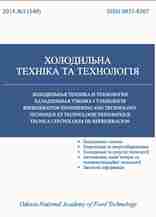APPROACH TO THE CHOICE OF ROUTING PROTOCOL FOR NETWORKS OF THE FUTURE
DOI:
https://doi.org/10.15673/0453-8307.3/2014.32579Keywords:
Keywords, routing protocol, theory of decision making, networks of the future.Abstract
The article presents the studies results of some aspects of networks of the future design. In this paper, most attention is paid to routing protocols. This theme was chosen because of its significant relevance and importance of networks of the future design, as one of the priority directions of further development of information and communication technologies. Internet Engineering Task Force (IETF) published a series of recommendations related to routing protocols, in particular the recommendation RFC 2328 describes the protocol OSPF v2, recommendation RFC 1771 contains the basic provisions of the protocol BGP v4. Based on this information, as well as some other data were analyzed in order to select a routing protocol for a specific task. The paper presents the most famous routing protocols. Relevant protocols are OSPF and BGP v4, supporting a large number of network nodes with high reliability and low service traffic. For non-large networks often is used RIP v2 due to the simplicity of its realization. IS-IS protocol is currently not widely used because it does not satisfy a very important requirement for modern networks, namely not support IP-routing. Protocols IGRP and EIGRP are developed by Cisco and implemented, primarily, on their equipment. It should be noted that this study is directed primarily to show that the task of choosing a routing protocol is a controversial issue and has a large dependence on various factors. These factors include: the purpose of creating a network, the number of nodes in the network, the requirements for scalability and reliability, convergence. To solve global issues appropriate to apply protocols OSPF and BGP, while BGP is a major dynamic routing protocol in the Internet. By considering a particular example of a small corporate network, for which is not necessary to use such protocols like: OSPF and BGP v4, which will be characterized by high complexity for this situation, RIP v2 is best suited. Consequently, the value of this lies in correct, competent and flexible approach to the choice of routing protocol for each case, according to the recommendations of various standards organizations.
References
REFERENCES
National Institute of Information and Communications Technology, Strategic Headquarters for New Generation Network R&D (2009), Diversity & Inclusion: Networking the Future Vision and Technology Requirements for a New-generation Network, February.
European Commission, Information Society and Media Directorate-General (2009), Future Internet 2020: Visions of an Industry Expert Group, May.
Y.3001: – Objectives and design goals [Electronic resource]. – Access mode: http://www.itu.int. – Access date: 19.02.14.
4.Y.3011: Framework of network virtualization for future networks. – [Electronic resource]. – Access mode: http://www.itu.int. – Access date: 19.02.14.
http://mathworld.wolfram.com/HasseDiagrm– [Electronic resource]. – Access mode: http://mathworld.wolfram.com. – Access date: 20.02.14.
6.Shelobaev S.I. Matematicheskie metody i modeli. Ekonomika.Finansy. Biznes. – M.:JUNITI, 2000, 356 s.
7.Moiseev N.M. Matematicheskie zadachi sistemnogo analiza. – M.: Nauka, 1981, 488 s.


